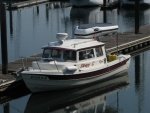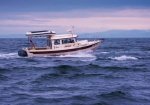Tough choice, for some. Good advice there too. Yes, I do prefer twins. (Joe has a great memory.) Lots of good reasons, but that is personal preference too, just like the brand of engines. Good advice, (Don't rush into something that will do, when it is not what you want.) Those are different levels of satisfaction and making the wrong choice will haunt you every time you crank the starter.
Since you are asking preferences, mine would be in this order: Yamaha, twins, radar, Barber seat. The floor is a non issue for me, but I like my bare boat bottom. (If there is an inch of water on the cockpit sole, I can see that. It happens. Splash and spray from wind and waves.)
Why not Honda. Boating in Canada with USA Honda is a crap shoot. IF anything goes wrong with the OB's, you are on your own. If you are not going to be in Canada waters, not an issue for you.
Twins, for maneuverability and redundancy.
Radar, (and I would add AIS), are HUGE safety and navigational pluses.
Barber seat, just adds more versatility to the boat.
Cockpit sole, already discussed.
I don't know about the upper limit of hours on the Hondas. If they were Yamis, I would think (if they are well taken care of, that they would go to 3000 plus, maybe to 4K. (That is what the water taxis are doing up on Vancouver Island.)
A good choice, take the boat with the twins, negotiate into the price an upcoming repower, and then put Yami's on it. It has radar so you can start boating right away.
I know Bob and I don't necessarily agree on the permatrims. If you have twins and trim tabs I think the permatrims are extra. Yes they will help in slow speed maneuvering, and they will help in boat trim, but you already have that with the tabs. On a single, I think they are beneficial, again with slow maneuvering around the dock, and for pushing the bow down at speed, especially if you do not have trim tabs, Then the permatrim is a must.
Harvey
SleepyC:moon



